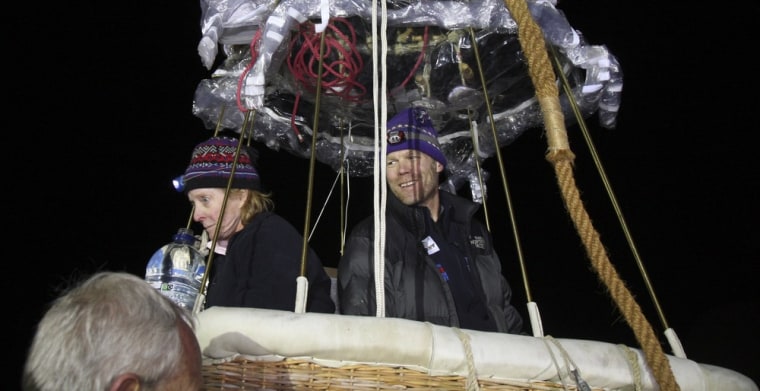Two missing American balloonists plunged toward the Adriatic Sea at 50 mph (80 kph) before disappearing from radar screens and likely didn't survive, race organizers said Friday.
Flight director Don Cameron said that high rate of descent, if confirmed, leads him to be "very pessimistic" about the fate of veteran pilots Richard Abruzzo and Carol Rymer Davis.
Abruzzo and Davis were participating in the 54th Gordon Bennett Gas Balloon Race when contact was lost Wednesday morning in rough weather over the Adriatic Sea.
Race organizers said the balloon "appears to have suffered a sudden and unexpected failure."
"It's very bad news," Cameron said. "At this rate of descent to the surface, survival would be unlikely."
Cameron said he received information Friday from Zagreb's air traffic control indicating the balloon was at 5,300 feet (1,615 meters) and descended at a rate of 50 mph until 600 feet (180 meters).
'Shred of hope'
Cameron stressed that the Croatian readings were from the outer limits of its radar zone, though, and said he hoped they were incorrect.
"It's the only shred of hope," he said, adding that he hoped to confirm the data with Italian air traffic controllers in Brindisi, on the other side of the Adriatic, on Saturday.
The Italian coast guard, the U.S. Navy and Croatian coastal aircraft crews have been scouring the area around Croatia's distant, uninhabited islet of Palagruza.
The Abruzzo name is synonymous with ballooning. Abruzzo is the son of famed balloonist Ben Abruzzo, who was in 1981 part of the first team to cross the Pacific Ocean by balloon, and who was killed in a small airplane crash in 1985.
The younger Abruzzo and Davis won the 2004 edition of the Gordon Bennett race and the 2003 America's Challenge gas race — one of Abruzzo's five victories in that race.
Abruzzo's wife, Nancy, was in Bari at coast guard headquarters on Friday monitoring the search effort. She said her husband had made a final radio transmission saying he was preparing to ditch in the sea.
"We have every reason to believe that with his final transmission to air traffic that he would have had enough, you know, an adequate amount of time to prepare for an emergency sea landing which, you know, they are very prepared for," Nancy Abruzzo said.
She said she had been ballooning with her husband for 17 years.
"It's in his blood. It's who he is. This is what he loves. This is his passion," said Abruzzo, who spoke to the AP via cell phone before word about her husband had come through.
But the Italian coast guard was unaware of any final radio transmission, said spokesman Lt. Massimo Maccheroni. He said the coast guard merely received information about the last automatic signal the balloon communicated to the air traffic control center in Bridinsi before losing contact.
'You've got to go fly'
In the 2005 Gordon Bennett race, Richard Abruzzo and Davis hit a power line in Kansas. Abruzzo fell out, suffering several broken bones. Davis landed the balloon safely, although she suffered bruises when she was dragged along the ground while landing the lightly loaded balloon in 40 knot winds.
Richard Abruzzo and Davis finished third in the 2006 America's Challenge gas balloon race by traveling 1,478 miles from the Albuquerque International Balloon Fiesta.
Most gas balloon racers — including Abruzzo and Davis — are hobbyists who spend thousands of dollars on the high-flying adventure sport. The balloons are designed specifically for racing, equipped with a satellite telephone, VHF radios, radar transponder and two mobile telephones. In this race, the team tried to fly the farthest on a maximum of about 1,000 cubic meters (35,300 cubic feet) of gas.
Word of the pair's disappearance came on the eve of New Mexico's annual balloon fiesta. Organizers of that event said it would go on as planned.
"They'd come back and kick us in the rear if we didn't have it, so it's one of those things that's in the spirit of what we do as gas balloon pilots," America's Challenge Deputy Director Kevin Knapp .
"Richard, he would be saying you've got to go fly, I mean there's no reason that you need to stay on the ground because I'm out here floating around in the ocean," Abruzzo's former flying partner and teacher Troy Bradley added.
